#100-200 KW
Explore tagged Tumblr posts
Text
#Global Single-Phase Immersion Cooling System Market Size#Share#Trends#Growth#Industry Analysis By Type(Less than 100 KW#100-200 KW#Great than 200 KW)#By Application( Data Center#High Performance Computing#Edge Application#Others)#Key Players#Revenue#Future Development & Forecast 2023-2032
0 notes
Text

QUANDO LA RAGIONE SI TRASFORMA IN FOLLIA E LA FOLLIA SUPERA IL LIMITE
La potenza impegnata per uso domestico è, di solito, 3 kWe. Un condominio di 100 famiglie impegna complessivamente una potenza di 300 kWe, che in un giorno (24 ore) diventano 7200 kWh, in un anno diventano 2628000 kWh (2628 MWh).
Se volessimo ricarica un'auto elettrica con batteria di capacità pari a 90 kWh, teorizzando un rendimento di ricarica dell'85%, avremmo di bisogno di 37.5 ore. Volendo ridurre i tempi di ricarica a poco più di 1 ora, avremmo di bisogno di una potenza impegnata di 105 kWe. Ma 105 kWe sono pari a più della metà del condominio e il tutto per una sola auto.
Facciamo finta che nel condominio di 100 famiglie tutti abbiano un'auto elettrica con batteria della capacità citata e il condominio ottiene il via libera per 100 stazioni di ricarica "media" da 105 kWe.
La potenza impegnata è pari a 105000 kWe, ovvero 105 MWe, ovvero 105 MWh di energia, ovvero quasi la potenza di un reattore nucleare modulare (SMR) come il Liong One cinese da 125 MWe!
Giusto per fare comprendere la proporzione, con 105 MWe si alimenta una città (senza industrie, naturalmente) di 35 mila abitanti! Adesso provate ad immaginare una città con, almeno, la metà del parco auto circolante di tipo elettrico e tante stazioni di ricarica dalla potenza di, almeno, 105 kWe.
Milano, inteso come Comune, conta su 1.4 milioni di abitanti, e con il 50% di 1807123 parco auto, le vetture elettriche sarebbero 903561. Volendo considerare che tutte le auto vengano ricaricate con colonnine rapide da ipotetici 105 kWe (in realtà si stanno diffondendo, insieme a quelle da 200 e oltre kWe, ma sono pochissime, la stragrande maggioranza sono da 36 kWe, ma noi agiamo ipoteticamente per consentire una ricarica in poco più di 1 ora), la potenza impegnata sarebbe di 948739605 kWe, pari a 94873,905 MWe, pari a 94,873905 GWe di potenza elettrica effettiva! Per giuste proporzioni, un reattore nucleare coreano APR-1400, dello stesso modello costruito in 4 unità negli Emirati Arabi Uniti, eroga una potenza massima netta di 1400 MWe, ovvero 1,4 GWe, e ne sarebbero necessari ben 68!
Qualcuno potrebbe obiettare: "Non è detto che tutte le auto si connettano contemporaneamente per la ricarica". Vero, ma la statistica dimostra, che la ricarica viene tendenzialmente effettuata nelle ore serali/notturne presso il proprio domicilio (in Italia per chi può permetterselo, in Germania e negli Stati Uniti è la prassi), più raramente presso le colonnine dislocate nei punti di ricarica urbani avviene di giorno. La statistica stessa ci viene incontro informandoci che ci sarà almeno una volta al giorno un momento in cui le auto possono essere collegate tutte insieme per la ricarica, e quella potenza va coperta, pena un inesorabile crollo delle linee e un prolungatissimo black-out che porterebbe dietro di sé, non la Lombardia, non l'Italia, ma l'Europa intera, date le interconnessioni transfrontaliere.
Ammesso che i cittadini si "accontentino" di ricaricare le proprie auto alla potenza massima di 3 kWe, sarebbero comunque necessari 2710683 kWe, 2710,683 MWe, 2,710683 GWe di potenza per ricaricare, in un tempo stimato di 38 ore circa, il 50% delle auto di Milano, quindi 2 reattori nucleari APR-1400.
Qualcuno afferma di volere ricaricare le auto elettriche, di giorno e con i pannelli FV. Torniamo all'esempio delle colonnine da 105 kWe, tanto il sole è gratis, giusto? I pannelli FV in condizioni standard hanno un rendimento del 13% (in termini largamente benevoli, perché raramente si arriva a superare il 10% reale...). Il 13% di rendimento è considerato come valore massimo in condizioni di perfetta perpendicolarità del pannello FV rispetto all'irraggiamento solare, alla temperatura di 25°C e al livello del mare. La variazione dell'angolo incidente, della temperatura e della pressione atmosferica riducono sensibilmente il rendimento effettivo...
Considerata la costante solare K = 1 kW * m-2, 1 metroquadrato di pannello FV erogherà una potenza massima di 130 Watt...
Per ottenere una potenza massima di uscita pari a 2,710683 GWe saranno necessari 20851407,692 m*-2 di pannelli fotovoltaici... credo le proporzioni, adesso, siano ben chiare! Continuare a fare conversazione su questi numeri, credo, sia inutile. Al netto degli impatti ambientali per la produzione delle batterie, dei pannelli FV, della loro installazione sul suolo, anche e solo parlare di elettrificare anche una parte del parco circolante di una città come Milano, figuriamoci del mondo intero, sia un qualcosa di improponibile, al netto, che senza reattori nucleari, la ricarica potrebbe essere assicurata per non più di 5,479 ore/giorno in media di irradiazione solare annue in Italia... Meditare, gente, meditare...
F. Arnò.
88 notes
·
View notes
Text
An introduction to VR locomotives, part 6/7: the Sr3
So we come to our newest class of electric locomotives: the Sr3, a version of the Siemens Vectron adapted for the needs of the Finnish railway system. Aka the Vector, or as I like to call them, the Chunky Beauty.
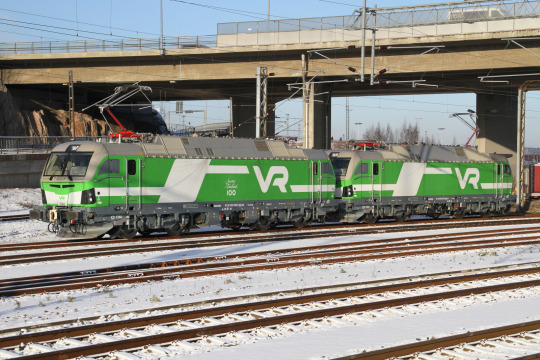
A total of 80 hot chubbies were ordered in 2013 for delivery in 2016-26, with an option for 97 further units. And as you can see, we decided to paint them in a sexy livery of green with white highlights, rather than the other way around.
The Sr3 is, in fact, slightly slower than the older Sr2 class, with a top speed of "only" 200 km/h – but it's also more powerful, with an output of 6 400 kW (compared to 6 100 kW on the Sr2). Additionally, the Sr3's are equipped with diesel generators, which will allow them to perform shunting duties on non-electrified tracks, such as around wood terminals, doing away with the need for a separate diesel shunter. Truly a machine that is as versatile as it is attractive.
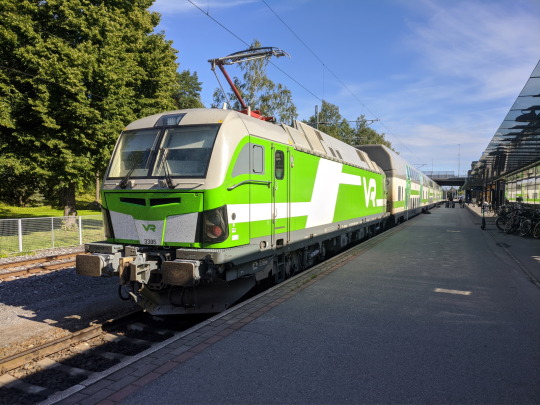
Alas, things with the chonksters didn't quite work perfectly in the beginning: the automatic train control systems of the trains, which were made to the new ETCS European standards, didn't properly communicate with the existing Finnish JKV system. This resulted in the locomotives doing emergency braking without reason at random times.
With the teething problems fixed, the Sr3 has proven a reliable workhorse – so reliable in fact, that our privately-owned competitor Fenniarail (boo! hiss!) have taken delivery of one Sr3 of their own.
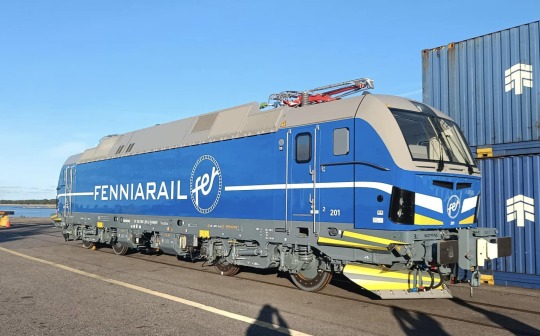
We of course have 58 big... not really sure what their gender is... and counting. But I admit it does look good in Fer's blue too.
33 notes
·
View notes
Text
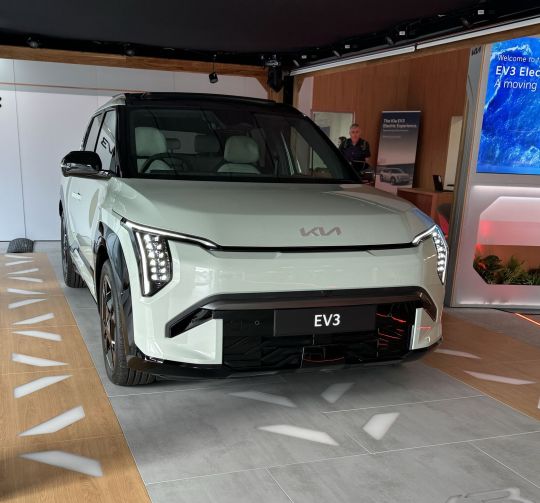

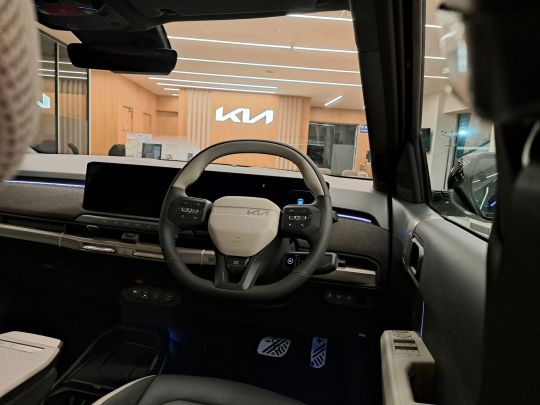


Kia EV3 Electric Car Lease
But how will the new EV3 perform - is it a good EV? The brand have confirmed two battery derivatives will be available for the UK market including:
EV3 Standard Range - the 55 kWh lithium-ion battery will offer 0 – 62 times of 7.5 seconds, 106 mph top speeds and 150 kW (or 201 hp). This model is a FWD option. Expect a combined winter range of 170 miles with warmer weather allowing for 230 miles - 200 miles combined. On charging, the 11 kW AC max will allow 6 hour 0 – 100% charging times with the 100 kW DC maximum allowing 32 minute 10 – 80% times. This has a cargo volume of 460L and vehicle fuel equivalent of 147 mpg. The EV3 will feature bidirectional charging - a 3.6kW AC Vehicle-to-Load (V2L). An indoor and outdoor port means you can power external devices too; and
EV3 Long Range - the 78 kWh lithium-ion battery will offer 0 – 62 times of 7.7 seconds, 106 mph top speeds and 150 kW (or 201 hp). This model is a FWD option. Expect a combined winter range of 235 miles with warmer weather allowing for 320 miles - 280 miles combined. On charging, the 11 kW AC max will allow 8 hour and 30 min 0 – 100% charging times with the 135kW DC maximum allowing 33 minute 10 – 80% times. This has a cargo volume of 460L and vehicle fuel equivalent of 145 mpg. The EV3 will feature bidirectional charging - a 3.6kW AC Vehicle-to-Load (V2L). An indoor and outdoor port means you can power external devices too.
3 notes
·
View notes
Photo
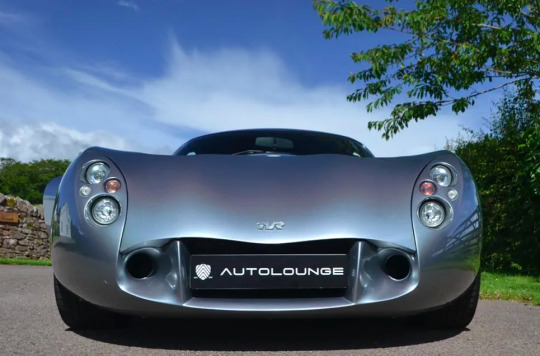
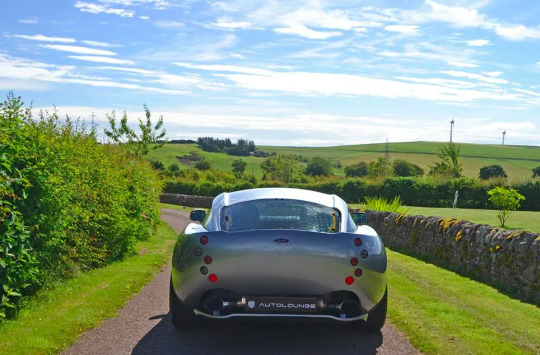


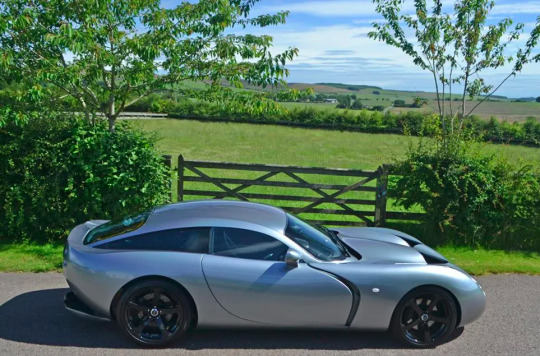





TVR T440R (1 of 1)
A true homologation special, this TVR T440R is the only one of its kind ever produced. Made to homologate an endurance race car in 2003, the car was only recently recommissioned and is up for sale.The story of the TVR T440R starts with the T400R (aka the Typhon) race cars that were built to compete in endurance racing at Spa, Sebring, in British GT, and, of course, Le Mans. In order to obtain FIA homologation, TVR had to build four road cars.The British company chose to build three Typhons and this, the T440R. The Typhons were initially supposed to feature a supercharged 4.0-liter straight-six but were instead finished with a naturally aspirated 4.0-liter engine.
The T440R, meanwhile, was fitted with a naturally aspirated, 4.2-liter straight-six that incorporated a gas-flowed cylinder head, a steel crankshaft and conrods, as well as a carbon fiber airbox with six upper injectors and bespoke exhaust headers. For road use, the engine makes 440 hp (446 PS/328 kW), down from the supercharged race car’s 585 hp (593 PS/436 kW). The underfloor is flat for better aerodynamics and is made of resin-sandwiched aluminum honeycomb. A separate carbon-fiber tub is bonded to the chassis and the carbon fiber bodywork is bonded to the tub and the floor.
Thanks to its power and lightweight construction, the car will hit 62 mph (100 km/h) in just four seconds and can go all the way up to 200 mph (320 km/h). Quite impressive numbers for 2003, and still more than respectable today.
Inside, the T440R has four seats and plenty of exposed carbon fiber, as well as Willans racing harnesses. The seats are trimmed in red and black leather and the Alcantara headliner is a surprisingly modern touch.
78 notes
·
View notes
Text

AMG GT63 S E PERFORMANCE „The ULTIMATE GT“.
Affalterbach. With a system output of 620 kW (843 hp) and a maximum system torque of more than 1400 Nm, the Mercedes-AMG GT 63 S E PERFORMANCE (fuel consumption weighted, combined: 7.9 l/100 km; weighted, combined CO2 emissions: 180 g/km; power consumption weighted, combined: 12.0 kWh/100 km)[1] is a new milestone in the company’s history.
The four-door coupé is the first performance hybrid and at the same time the most powerful series-production model of the brand from Affalterbach to date. The combination of 4.0-litre V8 biturbo engine and electric motor ensures superior driving performance and outstanding driving dynamics with impressive efficiency at the same time.
Mercedes-AMG is forging its own technical path to transport its hallmark brand DNA into an electrified future. To achieve this, the Affalterbach-based company uses, for example, technologies from Formula 1 in its E PERFORMANCE Hybrid strategy. The concept includes an independent drive layout with an electric motor and battery on the rear axle.
In the AMG GT 63 S E PERFORMANCE, the system consists of a 4.0‑litre V8 biturbo engine with a permanently excited synchronous electric motor, a high-performance battery developed by AMG and the fully variable AMG Performance 4MATIC+ all-wheel drive system.
The system power of 620 kW (843 hp) and the maximum system torque of more than 1400 Nm enable acceleration from a standstill to 100 km/h in just 2.9 seconds. After less than ten seconds, 200 km/h are reached. Acceleration only ends at 316 km/h.
Mercedes-AMG One man, one engine Handcrafted by Michael Kübler @f1mike28 in Germany Affalterbach.
Driving Performance is my Passion! Mercedes-AMG the Performance and Sports Car Brand from Mercedes-Benz and Exclusive Partner for Pagani Automobili. Mercedes-AMG Handcrafted by Racers.
#amg#amggt#amggt63s#amggt63#gt63s#gt63#mercedesamg#mercedes#mercedesbenz#affalterbach#onemanoneengine
9 notes
·
View notes
Text
Galvenie FOTON eAUMARK kravas pašizgāzēja raksturlielumi:
Paceļama kravas kaste – iespēja izgāzt kravu uz trīs pusēm, ar nolaižamiem bortiem visās trīs pusēs.
Mehāniski pārvelkams kravas kastes tents – nodrošina aizsardzību un ērtu kravas pārsegšanu.
Automašīnas pilna masa – 6 tonnas, kravnesība – 3,5 tonnas.
Efektivitāte – ar vienu uzlādi un pilnu kravu iespējams nobraukt 200 km.
CATL baterijas ietilpība 81,14 kWh. Jauda 115 KW.
Uzlādes iespējas: gan ātrā, gan lēnā uzlāde (DC/AC). No 20% līdz 100% DC uzlāde aizņems stundu, bet AC apmēram 7 stundas (atkarīgs no uzlādes stacijas).
An opportunity to try the FOTON eAUMARK electric dump truck. 100% electric, zero emissions - exactly what is needed to develop the sustainability of the company!
Main characteristics of FOTON eAUMARK cargo dump truck: Liftable cargo box - the possibility of dumping cargo on three sides, with drop-down sides on all three sides. Mechanically retractable cargo box awning - provides protection and convenient cargo covering. The full weight of the truck is 6 tons, the carrying capacity is 3.5 tons. Efficiency – with one charge and a full load it is possible to travel 200 km. CATL battery capacity 81.14 kWh. Power 115 KW. Charging options: both fast and slow charging (DC/AC). A DC charge from 20% to 100% will take an hour and AC about 7 hours (depending on the charging station).
#Latvia#ev test drive#electric dump truck#electric vehicle#FOTON eAUMARK#ev adoption#russian defeat#demise of big oil#electric truck
2 notes
·
View notes
Text
17. Mai 2023
Ladestationen für E-Autos – die Oper
Wir müssen heute in Franken etwas erledigen, und da wir früh da sein müssen, fahren wir am Vorabend los und übernachten ca. 100 km vor unserem Ziel in einem Hotel an einem Rastplatz.
Da unser Hyundai Kona nur 39 kWh an Strom tanken kann und wir bei normaler Fahrt (also nicht reine Autobahn und schon gar nicht eine Berg- und Talstrecke wie in Franken) knapp unter 13 kWh pro 100 km liegen, kommen wir bei dieser Fahrt auf reale 270–280 km Reichweite. Nach rund 200 km sucht N auf dem Navi eine auf der Strecke liegende Schnellladestation heraus. Diese befindet sich auf einem Rastplatz und gegen 20 Uhr kommen wir dort an.
Ladestationen an Autobahnen sind in den meisten Fällen Parkplätze, an denen die massigen Schnelllader aufgebaut sind. In diesem Fall standen die Schnelllader zwischen den Parkplätzen, und alle vier waren belegt.
Als wir am Reisebus vorbeifuhren, der vor den Ladestationen halb auf einigen freien normalen Parkplätzen stand, sprach der Busfahrer uns an. Vor uns sei der Tesla an der Reihe, der gegenüber den Ladestationen parkt, er selber müsse seinen Bus auch laden und würde die erste der Ladesäulen dafür ca. 1 Stunde nutzen, wenn sie frei wird. Andere Säulen kann er nicht nutzen, weil er dann alle Ladeplätze blockieren würde. Der Bus war tatsächlich von ebusco, einer Firma, die E-Busse betreibt.
Der Tesla übernahm den Platz eines VW ID4, als dieser fertig geladen hatte, ein Hyundai Ionic fuhr kurz darauf auch fort und wir nahmen dessen Ladesäule. Als ich gerade den Ladevorgang gestartet hatte, konnte der Bus auch an seine Ladesäule – und diese stürzte nach dem Start des Ladevorgangs ab und reagierte nicht mehr.
Als wir von der Toilette zurück kamen, telefonierte der Busfahrer gerade mit dem Säulenbetreiber.
Das mit den Ladesäulen funktioniert in Deutschland so:
Die Ladesäulen werden von Firmen betrieben, mit denen ich einen Vertrag abschließe, um sie zu nutzen. Es gibt Verträge mit Grundgebühr und Gebühren für den Ladevorgang, mit pauschalen monatlichen Gebühren oder ohne monatliche Zahlung nur auf Basis des Verbrauchs. Zu den Verträgen gehört meist eine Chipkarte oder ein Chipanhänger für den Schlüsselbund, um die Ladesäulen freizuschalten.
Die meisten der Verträge unterstützen bei Reisen auch ein Roaming, also die Nutzung von Ladesäulen anderer Betreiber. Aber die Preise sind mitunter nicht vorhersehbar.
Wir haben zwei solche Chips, einen von den örtlichen Stadtwerken, den NEW, und einen von EnBW, der nach den Berichten in den Foren die wenigsten Zicken beim Roaming macht.
Zu beiden gehören Apps, in denen man die jeweiligen Preise an den Ladestationen ablesen kann, ob diese gerade belegt sind und einiges mehr. Die heimischen Ladestationen kosten über den NEW-Vertrag aktuell 45 ct pro kWh bei bis zu 22 kW. 65 ct pro kWh zuzüglich einer Blockiergebühr von 12 ct pro Minute nach Abschluss des Ladevorgangs will EnBW derzeit an denselben Säulen haben.
Die Schnelllader an Autobahnen, die bis 240 kW Ladeleistung haben (unser Wagen kann bis zu 50 davon nutzen), sind in der Regel teurer.
An manchen Autobahnraststätten sind auch Ladestationen mehrerer verschiedener Anbieter, die bei demselben Roaminganbieter verschiedene Preise haben. Manche Säulen, besonders oft die des pöttisch “E.off” genannten Anbieters, sind mitunter nicht aktiv oder reagieren nicht oder sind nicht mehr geeicht und funktionieren trotzdem, was ein Glücksfall ist, weil sie dann nicht abgerechnet werden dürfen.
Dass die meisten Ladestationen umfunktionierte Parkplätze sind, ist suboptimal. Es gibt keine Warteschlangen, man muss sich verständigen, wer als nächstes dran ist, und dass ein bestimmter Typus des homo sapiens dieselnasensis sich gelegentlich mit seinem Verbrennerfahrzeug vor dem E-Auto auf den Ladeplatz stellt, dort natürlich nicht lädt und über Beschwerden nur lacht, wird in den Foren auch schon mal berichtet.
Einzelne neu gebaute Ladestationen sind hingegen groß wie eine Tankstelle und ähnlich gestaltet. Jede Ladesäule kann zwei Fahrzeuge gleichzeitig laden, die Fahrzeuge stehen links und rechts parallel neben der Ladesäule und es gibt ein Dach aus Solarzellen darüber, das vor Regen schützt. Außerdem gibt es meist einen Fahrstreifen, auf dem sich eine Warteschlange bilden kann.
“Die Dächer sind für meinen Bus aber meistens zu niedrig”, meinte der Busfahrer, als wir darüber sprachen. Unser Auto war auf 80% geladen und wir fuhren weiter.
Das Hotel am Rastplatz Spessart Süd erreichten wir mit 55 km Restreichweite.
Heute früh suchte ich in den einschlägigen Apps die Ladestationen, mit denen auf der bekannten Buchungs-Website geworben wurde. ���280 m entfernt” stand da. Ich fand sie jenseits der Autobahn auf dem Rastplatz der anderen Fahrtrichtung.
Die Navi-Apps kamen auf rund 35 km Fahrtstrecke dorthin – einmal die Autobahn von unserem Rastplatz aus zur nächsten Ausfahrt fahren, dort in Gegenrichtung auffahren und zurück.
Die Dame an der Rezeption sprach davon, dass man auch vom Rastplatz auf die Landstraße käme, unter der Autobahn auf die andere Seite fahren und dort zum Rasthaus der Gegenrichtung gelangen könne und von dort “irgendwie auch auf den Rastplatz”.
Das hatte ich auf den Satellitenbildern von Google Maps auch schon gesehen, aber es sah so aus, als ob die Straße auf der falschen Seite des Rasthauses endete. Den Rastplatz selber schien man mit dem Auto nur über die Terrasse des Rasthauses erreichen zu können, was ich nicht versuchen wollte.
Inzwischen hatte ich einen Tesla Supercharger in Weibersbrunn in der Tesla-App gefunden. 3,5 km Luftlinie, 7 km über die Straße.
Tesla hat die meisten Supercharger inzwischen für alle Marken freigegeben, und wenn man sie nutzen will, braucht man keinen Chip, sondern lediglich die Tesla-App und eine Kreditkarte, die dort hinterlegt wird. Man stellt sich an die Ladesäule, stöpselt das Auto ein und sagt der App, an welcher Säule man jetzt laden will. Tesla bucht zumindest bei Debitkarten zu Beginn des Ladevorgangs 25 € ab und erstattet den nicht verbrauchten Betrag unmittelbar nach dem Laden.
Allerdings hat Tesla die Ladebuchsen bei den Autos immer hinten über dem Kotflügel links. Die Supercharger sind auch Parkplätze, an deren Kopfende rechts die stylische Ladesäle steht. Fährt man einen Tesla rückwärts auf den Platz, reicht das Ladekabel der Säule exakt, die Ladebuchse befindet sich ja direkt neben der Säule.
Unser Hyundai hat die Ladebuchse aber vorne links. Ich musste ihn also wieder schräg und sehr nah an der Säule abstellen. Außerdem scheinen der Hyundai und die Supercharger sich nicht zu 100% zu verstehen, der Ladestrom ging nicht über 36 kW hinaus.

Aber Hauptsache Strom und in der Wartezeit ein hübsches Ambiente.
(Volker König)
8 notes
·
View notes
Text
Tôi có nhu cầu mua máy rửa xe JETTA cho tiệm rửa xe vừa và nhỏ thì mua máy rửa công suất bao nhiêu ?
máy rửa xe
Để lựa chọn công suất phù hợp cho máy rửa xe JETTA của bạn, bạn cần xác định nhu cầu của tiệm rửa xe của mình. Nhu cầu này bao gồm kích thước của xe, mức độ bẩn của xe và số lượng xe bạn dự định rửa mỗi ngày.
Nếu bạn có một tiệm rửa xe nhỏ với nhu cầu rửa xe không quá nhiều, bạn có thể chọn máy rửa xe có công suất 1.8kw hoặc áp lực nước 100 bar. Máy có công suất này sẽ đáp ứng được nhu cầu rửa xe của bạn một cách hiệu quả và tiết kiệm điện năng và nước.

Nếu bạn có một tiệm rửa xe vừa vừa phải, với nhu cầu rửa xe mức trung bình, bạn nên chọn máy rửa xe có công suất 3 kw hoặc áp lực nước 150 bar. Máy có công suất này sẽ đảm bảo rằng bạn có thể rửa xe một cách nhanh chóng và hiệu quả hơn, đồng thời giảm thiểu thời gian chờ đợi của khách hàng.

Nếu bạn có một tiệm rửa xe lớn, với nhu cầu rửa xe cao và thường xuyên, bạn nên chọn máy xịt rửa xe có công suất 5.5 kw hoặc áp lực nước 200 bar. Máy có công suất này sẽ giúp bạn rửa xe một cách nhanh chóng và hiệu quả hơn, đồng thời đáp ứng nhu cầu rửa xe của bạn.

Ngoài ra, bạn cũng nên lưu ý rằng các yếu tố khác cũng ảnh hưởng đến hiệu quả của máy rửa xe, chẳng hạn như lưu lượng nước, áp lực nước, loại béc phun và độ bền của máy. Do đó, trước khi quyết định mua máy rửa xe JETTA, hãy tìm hiểu kỹ về các yếu tố này để có thể chọn được máy rửa xe phù hợp nhất
Tìm hiểu thêm về thanh lý cầu nâng ô tô cũ
3 notes
·
View notes
Text
Allen Bradley PowerFlex (VFDs) Power Ratings

PowerFlex 4M AC Drive
100-120V: 0.2.1.1 kW / 0.25...1.5 Hp/1.6.6 A
200240V: 0.2...7.5 kW / 0.25...10 Hp/1.6...33 A
380.480V: 0.4...11 kW/0.5... 15 Hp/1.5...24 A
PowerFlex 523 AC Drives
100...120V: 0.2...1.1 kW / 0.25...1.5 Hp
200...240V: 0.2.15 kW / 0.25...20 Hp
400V/480V/525V/600V: 0.4...22 kW / 0.5...30 Hp
PowerFlex 525 AC Drives
100...120V: 0.2...1.1 kW / 0.25...1.5 Hp
200...240V: 0.2...15 kW / 0.25...20 Hp
400V/480V/525V/600V: 0.4...22 kW / 0.5...30 Hp
#automation#tumblr trends#bestdeals#allen bradley#plc#trendingnow#viral#rockwell automation#allenbradley rockwellautomation hmi panelview panelviewplus techpage#Automotive#TEchnology#Tech#VFD#PLC#HMI
1 note
·
View note
Text
44% Increase in Excise Duty Collection from EVs
100-200 kW EV imports up 713%, revenue collection up 574% KATHMANDU, Jan 21: While the number of electric vehicles (EVs) imported in the first half of the current fiscal year saw a moderate increase of 7 percent as compared to the corresponding period of the previous fiscal year, the excise duty collected by the government from those imports has skyrocketed by 44 percent. The import of EVs of the…
0 notes
Text
Installing a 10 kW solar counter rack in Nashik MH
youtube
About Counter Rack:
Counter Rack EW system is one of the best solutions for roofs facing east-west direction. This solution is optimal for harvesting clean energy from the sun. Since the panels face the south direction.
Features of Counter Rack:
• Counter Rack is majorly made up of Aluminum, resulting in corrosion-free and higher recyclable value of the material adding more extensive benefits post-material life.
• This racking system is compatible with a wider range of solar panels.
• Tilt Degree 50 to 100
• Design Windspeed Up to 200 kmph
• Easy and fast installation.
• Less number of pre-assembled SKUs.
• Ease of accessibility to perform maintenance operations.
0 notes
Text






And how does the Mazda 6 perform?
6e standard - from £38,000 the RWD saloon option will have a 66 kWh usable battery which will offer 0 – 62 times of 7.6 seconds, 109 mph top speeds and 190 kW (or 255 hp). Expect a combined winter range of 200 miles with warmer weather allowing for 275 miles. On charging, the 11kW AC max will allow 5 hours and 15 min 0 – 100% charging times with the 200 kW DC maximum allowing 23 minute 10 – 80% times. A cargo volume of 330L is available with this car. It has a vehicle fuel equivalent of 147mpg. This option can tow 750kg (unbraked) and 1500kg (braked). No Bidirectional charging has been announced. A Heat Pump is standard;
6e Long Range - from £42,000 the RWD saloon option will have a 75 kWh usable battery which will offer 0 – 62 times of 7.8 seconds, 109 mph top speeds and 180 kW (or 241 hp). Expect a combined winter range of 230 miles with warmer weather allowing for 315 miles. On charging, the 11kW AC max will allow 5 hours and 15 min 0 – 100% charging times with the 95 kW DC maximum allowing 47minute 10 – 80% times. A cargo volume of 330L is available with this car. It has a vehicle fuel equivalent of 148 mpg. This option can tow 750kg (unbraked) and 1500kg (braked). No Bidirectional charging has been announced. A Heat Pump is standard.
2 notes
·
View notes
Link
0 notes
Text
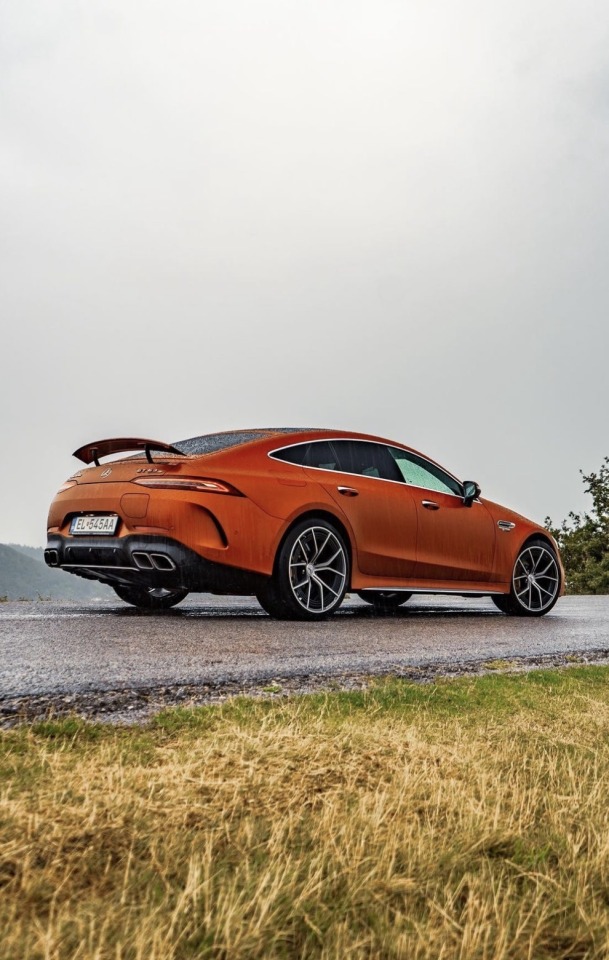
AMG GT63 S E PERFORMANCE „The ULTIMATE GT“.
Affalterbach. With a system output of 620 kW (843 hp) and a maximum system torque of more than 1400 Nm, the Mercedes-AMG GT 63 S E PERFORMANCE (fuel consumption weighted, combined: 7.9 l/100 km; weighted, combined CO2 emissions: 180 g/km; power consumption weighted, combined: 12.0 kWh/100 km)[1] is a new milestone in the company’s history.
The four-door coupé is the first performance hybrid and at the same time the most powerful series-production model of the brand from Affalterbach to date. The combination of 4.0-litre V8 biturbo engine and electric motor ensures superior driving performance and outstanding driving dynamics with impressive efficiency at the same time.
Mercedes-AMG is forging its own technical path to transport its hallmark brand DNA into an electrified future. To achieve this, the Affalterbach-based company uses, for example, technologies from Formula 1 in its E PERFORMANCE Hybrid strategy. The concept includes an independent drive layout with an electric motor and battery on the rear axle.
In the AMG GT 63 S E PERFORMANCE, the system consists of a 4.0‑litre V8 biturbo engine with a permanently excited synchronous electric motor, a high-performance battery developed by AMG and the fully variable AMG Performance 4MATIC+ all-wheel drive system.
The system power of 620 kW (843 hp) and the maximum system torque of more than 1400 Nm enable acceleration from a standstill to 100 km/h in just 2.9 seconds. After less than ten seconds, 200 km/h are reached. Acceleration only ends at 316 km/h.
Mercedes-AMG One man, one engine Handcrafted by Michael Kübler @f1mike28 in Germany Affalterbach.
Driving Performance is my Passion! Mercedes-AMG the Performance and Sports Car Brand from Mercedes-Benz and Exclusive Partner for Pagani Automobili. Mercedes-AMG Handcrafted by Racers.
#amg#amggt#amggt63s#amggt63#gt63s#gt63#eperformance#mercedesamg#mercedes#mercedesbenz#affalterbach#onemanoneengine
5 notes
·
View notes
Text
Mukhayamantri Saur Swarojgar Yojana (MSSY)
Mukhayamantri Saur Swarojgar Yojana (MSSY)
A hearty greeting to the people of Uttarakhand from the Sustainable Himalayas family. People of the state, as you know, you can earn from Rs. 10,000 to Rs. 1,30,000 per month by installing a solar print un der the Mukhayamantri Saur Swarojgar Yojana (MSSY). Under this scheme, you will get a subsidy of 50% to 20% as per your area from the Ministry of Small and Medium Enterprises (MSME) as well as the facility of loan at low interest. Under this scheme, you are informed that the Sustainable Himalayas organization has been continuously working for the last 5 years to build smart villages in Uttarakhand, Himachal Pradesh, Jammu and the North Eastern states.
In this series, under the Sustainable Himalaya Uttarakhand State Solar Policy, any young entrepreneur, industrialist, who wants to set up his own solar plant or captive solar plant or rooftop solar plant, can join our organization today and earn a monthly income of Rs. 10,000 to Rs. 1,30,000 by setting up a solar plant of 20 KW to 200 KW on his land or leased land and selling the electricity produced to the state government enterprise UPCL. Under this scheme, the government will make a Power Purchase Agreement with you for 25 years and will pay you at the rate of Rs. 4.64 per unit.
Main points of Mukhayamantri Saur Swarojgar Yojana (MSSY):-
Under this Mukhayamantri Saur Swarojgar Yojana (MSSY), you can set up solar plants of 20 KW, 25 KW, 50 KW, 100 KW, 150 KW, 200 KW.
Maximum 200 kW per family You can install solar power plant of capacity upto 100 KW only
Only permanent residents of Uttarakhand will be eligible to apply under this Mukhayamantri Saur Swarojgar Yojana (MSSY). Technical standards for the scheme 1. Land required 250-300 Wm for 25 KW, 750-1000 Wm for 50 KW, 1500-2000 Wm for 100 KW, 3000-4000 Wm for 200 KW shadowless land will be required 2. Estimated power generation From a 25 KW power plant, you will generate electricity worth Rs. 1,76,320 per year, from a 50 KW power plant, you will generate electricity worth Rs. 3,52,640 per year, from a 100 KW power plant, you will generate electricity worth Rs. 7,05,280 per year
At present, the power line has been installed by Uttarakhand Electricity Department at the rate of 4.64 per unit, 11 KVA power line has been installed by UPCL under the 100 kW to 200 kW capacity scheme, the maximum aerial distance from the transformer in the mountainous range of the Pacific provinces will be 300 meters and in the plain areas the maximum aerial distance will be 100 m, the Sukhshamu and Medium Enterprises(MSME) Ministry is giving grants ranging from 50% to 20% under the minimum written table, interest subsidy, small cost, other things to note, the landlord cannot legalize the ownership of his Apollo Power Plant to anyone else without the permission of UREDA,
the application for proprietorship will be accepted only as a proprietorship, the date of project share, within thirty days, the landlord will get group kill twenty thousand rupees on WhatsApp, Sukhshamu kid watt eight thousand rupees and two thousand kilowatt development One rupee in UREDA Project Karle in the form of FD or CDR which will be in the form of NFT or Demand Draft as given below 20 to 25 kW, Rs. 500 amount 50 to 100 kW, Rs. 2,000 amount 100 to 200 kW, Rs. 5,000 amount Scheme Order Documents.
For registration of this scheme, the applicant has to apply for the following documents Applicant’s Aadhar Card, PAN Card, copy of front page of passbook account details, mobile number, mail details, land details, copy of lease agreement also has to be submitted. Why only from our organization? Our organization has experience of setting up innovative plants from 3 kW to 250 kW in the previous years. In which we have included Mukhayamantri Saur Swarojgar Yojana (MSSY) in East Uttarakhand in many district and Surya Rooftop Yojana in Suryodaya Planned Places in entire Uttarakhand.
How to apply?
Alternatively, you can apply directly from the Uttarakhand government website www.mssy.uk.in. Or you can contact the team member of Sustainable Himalayas and submit your application. To apply, you can contact on the given number. For more information you can contact:- 7455853737, 9810075920
Name:- Abhilash Rana
Designation:- IT
Social Media:-
Website:- https://dysun.in/
0 notes